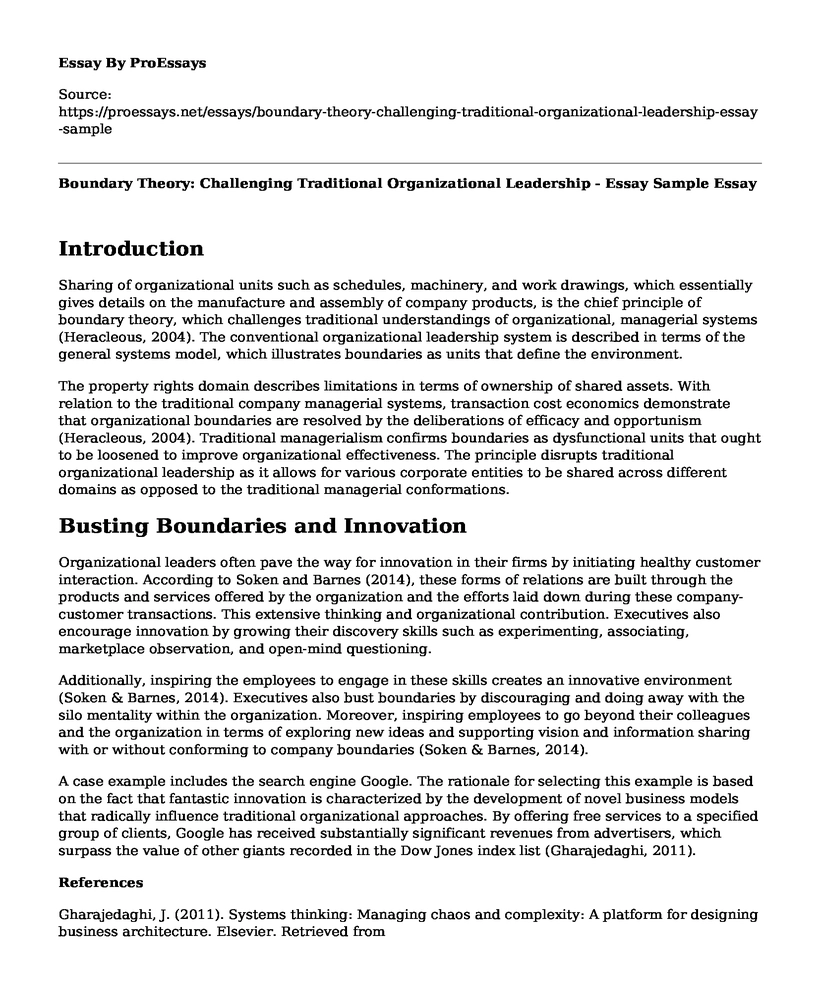Introduction
Sharing of organizational units such as schedules, machinery, and work drawings, which essentially gives details on the manufacture and assembly of company products, is the chief principle of boundary theory, which challenges traditional understandings of organizational, managerial systems (Heracleous, 2004). The conventional organizational leadership system is described in terms of the general systems model, which illustrates boundaries as units that define the environment.
The property rights domain describes limitations in terms of ownership of shared assets. With relation to the traditional company managerial systems, transaction cost economics demonstrate that organizational boundaries are resolved by the deliberations of efficacy and opportunism (Heracleous, 2004). Traditional managerialism confirms boundaries as dysfunctional units that ought to be loosened to improve organizational effectiveness. The principle disrupts traditional organizational leadership as it allows for various corporate entities to be shared across different domains as opposed to the traditional managerial conformations.
Busting Boundaries and Innovation
Organizational leaders often pave the way for innovation in their firms by initiating healthy customer interaction. According to Soken and Barnes (2014), these forms of relations are built through the products and services offered by the organization and the efforts laid down during these company-customer transactions. This extensive thinking and organizational contribution. Executives also encourage innovation by growing their discovery skills such as experimenting, associating, marketplace observation, and open-mind questioning.
Additionally, inspiring the employees to engage in these skills creates an innovative environment (Soken & Barnes, 2014). Executives also bust boundaries by discouraging and doing away with the silo mentality within the organization. Moreover, inspiring employees to go beyond their colleagues and the organization in terms of exploring new ideas and supporting vision and information sharing with or without conforming to company boundaries (Soken & Barnes, 2014).
A case example includes the search engine Google. The rationale for selecting this example is based on the fact that fantastic innovation is characterized by the development of novel business models that radically influence traditional organizational approaches. By offering free services to a specified group of clients, Google has received substantially significant revenues from advertisers, which surpass the value of other giants recorded in the Dow Jones index list (Gharajedaghi, 2011).
References
Gharajedaghi, J. (2011). Systems thinking: Managing chaos and complexity: A platform for designing business architecture. Elsevier. Retrieved from https://books.google.co.ke/books?hl=en&lr=&id=b0g9AUVo2uUC&oi=fnd&pg=PP1&ots=CDYdZxeD8v&sig=Jw1by8XCiXDiUFTaS3EAG0vSo18&redir_esc=y#v=onepage&q&f=false
Heracleous, L. (2004). Boundaries in the study of organization. Human Relations, 57(1), 95-103. Retrieved from https://doi.org/10.1177/0018726704042716
Soken, N. H., & Barnes, B. K. (2014). What kills innovation? Your role as a leader in supporting an innovative culture. Industrial and Commercial Training. Retrieved from https://doi.org/10.1108/ICT-09-2013-0057
Cite this page
Boundary Theory: Challenging Traditional Organizational Leadership - Essay Sample. (2023, Apr 12). Retrieved from https://proessays.net/essays/boundary-theory-challenging-traditional-organizational-leadership-essay-sample
If you are the original author of this essay and no longer wish to have it published on the ProEssays website, please click below to request its removal:
- Dr. Pepper Snapple Group Essay
- Research Paper Example on Consumer Behavior
- Five Forces of Competition: YWCA vs. Light House Mission & Sesame Flyers - Research Paper
- Research Paper on Disney's Low-Cost Integrated Differentiation Strategy
- Ensuring Data Protection in Nursing Organizations: A Strategy to Protect Patients' Data - Essay Sample
- Essay Example on Kitchen Essential Products Inc.: Ensuring Safety & Quality Through Duty Of Care
- Summary of a Critical Thinking Article - Free Paper Sample







